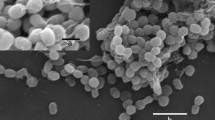Abstract
Two strains of Actinobacteria, ACTY and ACTR, were isolated from cellulolytic microbial communities obtained from an ombrotrophic Sphagnum peat bog. The strains were able to degrade cellulose, the main component of plant phytomass in this ecosystem. On the basis of their phenotypic and phylogenetic characteristics, the strains were identified as members of the genus Streptomyces. The isolates developed on media without available nitrogen sources and hydrolyzed cellulose within a temperature range of 5–25°C and in the pH interval from 4.5 to 6.0; they also exhibited acetylene reduction activity. Comparative analysis of the rates of cellulose degradation by the peat-inhabiting streptomyces at 5, 15, and 25°C and at pH values of 4.5 and 6.0, with and without a source of available nitrogen in the medium, indicated that high acidity and low temperatures, typical for boreal Sphagnum peat bogs, are the main factors limiting the growth and hydrolytic activity of these bacteria.
Similar content being viewed by others
References
Gorham, E., Northern Peatlands: Role in Carbon Cycle and Probable Responses to Climate Warming, Ecol. Applic., 1991, vol. 1, pp. 182–195.
Naplekova, N.N., Aerobnoe razlozhenie tsellyulozy mikroorganizmami v pochvakh Zapadnoi Sibiri (Microbial Aerobic Cellulose Decomposition in West Siberia Soils), Moscow: Nauka, 1974.
Verhoeven, J.T.A. and Toth, E., Decomposotion of Carex and Sphagnum Litter in Fens: Effect of Litter Quality and Inhibition by Living Tissue Homogenates, Soil Biol. Biochem., 1995, vol. 27, no. 3, pp. 271–275.
Mitchell, E.A.D., Buttler, G.A., Amblard, C., Grosvernier, P., and Gobat, J.-M., Structure of Microbial Communities in Sphagnum Peatlands and Effect of Atmospheric Carbon Dioxide Enrichment, Microb. Ecol., 2003, vol. 46, pp. 187–199.
Semenov, A.M., Nizovtseva, D.V., and Panikov, N.S., Effecn of Temperature and Mineral Elements on the Cellulase Activity and Micromycete Development in Peat Samples from an Ombrotrophic Bog, Mikrobiologiya, 1995, vol. 64, no. 1, pp. 97–103.
Semenov, A.M., Nizovtseva, D.V., and Panikov, N.S., Cellulase Activity in High Moors and Adjacent Automorphic Soils, Pochvovedenie, 1997, no. 1, pp. 64–68 [Eur. Soil Sci. (Engl. Transl.), no. 1, pp. 53–56].
Pankratov, T.A., Dedysh, S.N., and Zavarzin, G.A., The Leading Role of Actinobacteria in Aerobic Cellulose Degradation in Sphagnum Peat Bogs, Dokl. Akad. Nauk, 2006, vol. 410, no. 4, pp. 438–442 [Dokl. (Engl. Transl.), vol. 410, no. 4, pp. 428–432].
Kulichevskaya, I.S., Belova, S.E., Kevbrin, V.V., Dedysh, S.N., and Zavarzin, G.A., Analysis of the Bacterial Community Developing in the Course of Sphagnum Moss Decomposition, Mikrobiologiya, 2007, vol. 76, no. 5, pp. 702–710 [Microbiology (Engl. Transl.), vol. 76, no. 5, pp. 621–629].
Dedysh, S.N., Panikov, N.S., and Tiedje, J.M., Acidophilic Methanotrophic Communities from Sphagnum Peat Bogs, Appl. Environ. Microbiol., 1998, vol. 64, no. 3, pp. 922–929.
Weisburg, W.G., Barns, S.M., Pelletier, D.A., and Lane, D.J., 16S Ribosomal DNA Amplification for Phylogenetic Study, J. Bacteriol., 1991, vol. 173, pp. 697–703.
Stoschek, C.M., Quantitation of Protein, Methods Enzymol., 1990, vol. 182, pp. 50–68.
Zehr, J.P. and McReynolds, L.A., Use of Degenerate Oligonucleotides for Amplification of the nifH Gene from the Marine Cyanobacterium Trichodesmium thiebautii, Appl. Environ. Microbol., 1989, vol. 55, pp. 2522–2526.
Marusina, A.I., Bulygina, E.S., Kuznetsov, B.B., Turova, T.P., Kravchenko, I.K., and Gal’chenko, V.F., A System of Oligonucleotide Primers for the Amplification of nifH Genes of Different Taxonomic Groups of Prokaryotes, Mikrobiologiya, 2001, vol. 70, no. 1, pp. 86–91 [Microbiology (Engl. Transl.), vol. 70, no. 1, pp. 73–78].
Valdés, M., Pérez, N.-O., Estrada de los Santos, P., Caballero-Mellado, J., Peñ a-Cabriales, J.J., Normand, Ph., and Hirsh, A.M., Non-Frankia Actinomycetes Isolated from Surface-Sterilized Roots of Casuarina equisetifolia Fix Nitrogen, Appl. Environ. Microbiol., 2005, vol. 71, pp. 460–466.
Ehrlich, J., Gottlieb, D., Burkholder, P.R., Anderson, L.E., and Pridham, T.G., Streptomyces venezuelae, n. sp., the Source of Chloromycetin, J. Bacteriol., 1948, vol. 56, pp. 467–477.
Skerman, V.B.D., McGowan, V., and Sneath, P.H.A., Approved Lists of Bacterial Names, Int. J. Syst. Bacteriol., 1980, vol. 30, pp. 225–420.
Doroshenko, E.V., Bulygina, E.S., Spiridonova, E.S., Turova, T.P., and Kravchenko, I.K., Isolation and Characterization of Nitrogen-Fixing Bacteria of the Genus Azospirillum from the Soil of a Sphagnum Peat Bog, Mikrobiologiya, 2007, vol. 76, no. 1, pp. 107–115 [Microbiology (Engl. Transl.), vol. 76, no. 1, pp. 93–101].
Williams, R.T. and Crawford, R.L., Microbial Diversity of Minnesota Peatlands, Microbial Ecol., 1983, vol. 9, pp. 201–214.
Zakalyukina, Yu.V., Zenova, G.M., and Zvyagintsev, D.G., Acidophilic Soil Actinomycetes, Mikrobiologiya, 2002, vol. 71, no. 3, pp. 399–403 [Microbiology (Engl. Transl.), vol. 71, no. 3, pp. 342–345].
Schrempf, H., The Family Streptomycetaceae, Part I: Taxonomy, in The Prokaryotes: A Handbook on the Biology of Bacteria, 3rd edn, Dworkin, M., Falkow, S., Rosenberg, E., Schleifer, K.H., and Stackebrandt, E., Eds., New York: Springer, 2006, pp. 538–604.
Ribbe, M., Gadkari, D., and Meyer O. N2 Fixation by Streptomyces thermoautotrophicus Involves a Molybdenum-Dinitrogenase and a Manganese-Superoxide Oxidoreductase That Couple N2 Reduction to the Oxidation of Superoxide Produced from O2 by a Molybdenum-CO Dehydrogenase, J. Biol. Chem., 1997, vol. 272, no. 42, pp. 26627–26633.
Naplekova, N.N., Vliyanie azota i fosfora na intensivnost’ razlozheniya tsellyulozy i biologicheskuyu aktivnost’ pochv Zapadnoi Sibiri, in Voprosy chislennosti, biomassy i produktivnosti pochvennykh mikroorganizmov (Effect of Nitrogen and Phosphorus on the Rate of Cellulose Decomposition and the Biological Activity of West Siberian Soils), Leningrad: Nauka, 1972, pp. 207–215.
McCarthy, A.J., Lignocellulose-Degrading Actinomycetes, FEMS Microbiol. Rev., 1987, vol. 46, pp. 145–163.
Al-Tai, A.M., Abdul-Razzak, S., Al-Attiyah, S.S., and Abdul-Nour, B.A., Cellulase Production from Actinomycetes Isolated from IRAQI Soils: II. Cell Growth and Cellulase Activity of Streptomyces sp. Strain AT7 at Different Temperatures, J. Islamic Acad. of Sci., 1989, vol. 2–3, pp. 185–188.
Author information
Authors and Affiliations
Corresponding author
Additional information
Original Russian Text © T.A. Pankratov, S.N. Dedysh, 2009, published in Mikrobiologiya, 2009, Vol. 78, No. 2, pp. 268–274.
Rights and permissions
About this article
Cite this article
Pankratov, T.A., Dedysh, S.N. Cellulolytic streptomycetes from Sphagnum peat bogs and factors controlling their activity. Microbiology 78, 227–233 (2009). https://doi.org/10.1134/S0026261709020143
Received:
Published:
Issue Date:
DOI: https://doi.org/10.1134/S0026261709020143




